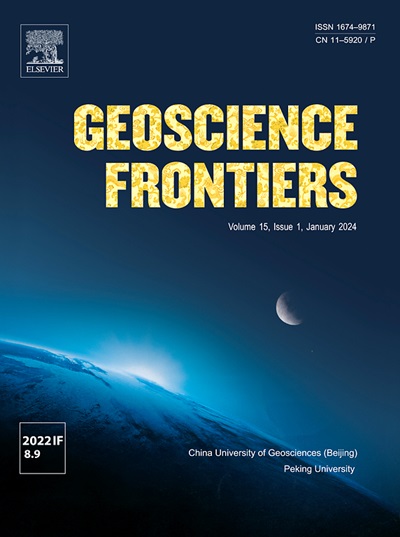卫星重力场与吸积微板的识别
IF 8.9
1区 地球科学
Q1 GEOSCIENCES, MULTIDISCIPLINARY
引用次数: 0
摘要
小型岩石圈地体(微板块)是大陆增生的重要组成部分,但它们的存在往往被随后的板块边缘变形事件和较年轻的火山-沉积盖层所掩盖。东安纳托利亚-高加索地区的地质构造是由欧亚板块西南大陆边缘的岩石圈地体序贯增生形成的。广泛的沉积和火山覆盖掩盖了该地区一些主要的构造边界,各种地体的数量和范围仍然存在主要的不确定性。我们从地壳厚度判断地形高度是否符合期望,是否符合均衡平衡。该研究的输入数据包括地形、卫星导出的重力场、定义岩浆侵入体和构造地体、弧和沉积盆地的地质知识、地震莫霍深度和地震层析成像模型。我们完成了由地震莫霍模型控制的地形-重力回归分析,该模型产生了明确的正异常和负异常。考虑到下地壳密度对比的变化,地形在很大程度上处于均衡平衡状态,并受地壳厚度的控制,即地形隆起与地壳增厚成正比。造山带下地壳平均密度差在200 ~ 300 kg/m3之间,局部有例外。区域重力场显著的正线性异常的反演定义了离散的地壳密度不均匀性,这些不均匀性可以解释为与特定的构造事件有关,从而对东安纳托利亚-高加索岩石圈聚集体的增生历史和整体解剖提供了有力的约束。在(i)大高加索地区、(ii)小高加索地区和(iii)小高加索地区以南约80公里处先前未确定的平行带中发现了三条地壳内密度增加的线状带。后者的重力异常首次清晰地描绘了南亚美尼亚地块的西南边缘,这是一个岩石圈元素(微板块),其存在与否长期存在争议。本文章由计算机程序翻译,如有差异,请以英文原文为准。

Satellite gravity fields and the identification of accreted microplates
Small-scale lithospheric terranes (microplates) are important building-blocks of continental accretion but their presence is often obscured by subsequent plate-margin deformation events and by younger volcano-sedimentary covers. The geological fabric of the eastern Anatolian-Caucasian region results from the sequential accretion of lithospheric terranes against the southwestern continental margin of the Eurasian plate. Widespread sedimentary and volcanic covers conceal some of the principal tectonic boundaries in the region, and major uncertainties persist as to the number and extent of the various terranes.
We determine whether the topographic height fits the expectance from crustal thickness, complying to the isostatic equilibrium. The input data of the study are the topography, the satellite derived gravity field, the geologic knowledge defining magmatic intrusions and tectonic terranes, arcs and sedimentary basins, the seismic Moho depth, and a seismic tomography model. We accomplish a topography-gravity regression analysis controlled by a seismic Moho model, which produces well defined positive and negative anomalies. Allowing for varying density contrast in lower crust, the topography is greatly in isostatic equilibrium and controlled by the crustal thickness, that is topographic uplift has evolved proportionally to crustal thickening. The average density contrast in lower crust is between 200 and 300 kg/m3 for the orogenic belt, with local exceptions.
The inversion of the prominent positive linear anomalies of the regional gravity field defines discrete crustal density inhomogeneities, which can be interpreted as related to specific tectonic events, thus placing cogent constraints on the accretionary history and the overall anatomy of the eastern Anatolian-Caucasian lithospheric agglomerate. Three linear belts of intracrustal increased density are found along (i) the Greater Caucasus, (ii) the Lesser Caucasus, and (iii) a previously unidentified parallel belt ca. 80 km south of the Lesser Caucasus. The latter gravity anomaly clearly delineates for the first time the southwestern margin of the South Armenian Block, a lithospheric element (microplate) whose existence has long been a matter of debate.
求助全文
通过发布文献求助,成功后即可免费获取论文全文。
去求助
来源期刊

Geoscience frontiers
Earth and Planetary Sciences-General Earth and Planetary Sciences
CiteScore
17.80
自引率
3.40%
发文量
147
审稿时长
35 days
期刊介绍:
Geoscience Frontiers (GSF) is the Journal of China University of Geosciences (Beijing) and Peking University. It publishes peer-reviewed research articles and reviews in interdisciplinary fields of Earth and Planetary Sciences. GSF covers various research areas including petrology and geochemistry, lithospheric architecture and mantle dynamics, global tectonics, economic geology and fuel exploration, geophysics, stratigraphy and paleontology, environmental and engineering geology, astrogeology, and the nexus of resources-energy-emissions-climate under Sustainable Development Goals. The journal aims to bridge innovative, provocative, and challenging concepts and models in these fields, providing insights on correlations and evolution.
 求助内容:
求助内容: 应助结果提醒方式:
应助结果提醒方式:


